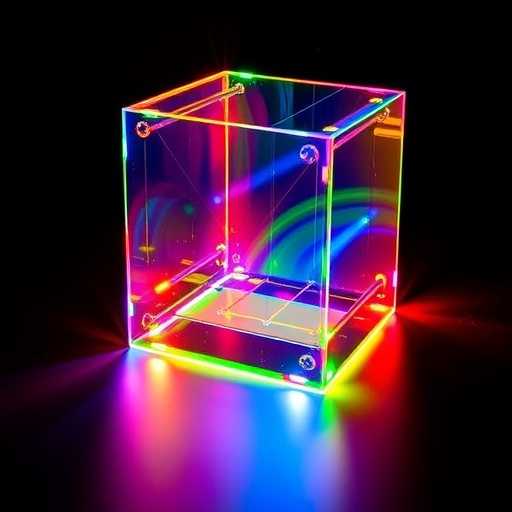In a groundbreaking advancement set to transform the realm of spectroscopic analysis, researchers have unveiled RAFAEL, an integrated lithium niobate photonic system that heralds a new era in ultra-high-resolution, high-efficiency snapshot spectroscopy. This innovative technology bridges a longstanding gap in optical spectrometry, overcoming the conventional trade-offs that have historically confined spectral precision and data acquisition speed.
Spectroscopy—the measurement of light to decode the physical and chemical signatures of objects—remains a cornerstone across multiple scientific disciplines, from astrophysics to biomedicine. Traditionally, achieving fine spectral resolution necessitates narrow slits or gratings that limit the amount of light entering the instrument, thereby sacrificing sensitivity and throughput. RAFAEL’s distinctive design harnesses bulk lithium niobate, a nonlinear crystal known for its electro-optical properties, creating an electrically tunable interference mask at the pixel level.
This architecture allows for a spectral response that can be modulated at picometre precision, enabling RAFAEL to achieve an astonishing spectral resolution of approximately 0.5 Ångströms across the visible to near-infrared range (400–1,000 nm), corresponding to a resolving power (R) of 12,000. The system’s capability outpaces existing spectroscopic imagers dramatically, doubling total optical transmittance to 73.2% while operating at a rapid 88 frames per second, all coupled with a spatial resolution encompassing over four million pixels (2048 × 2048).
Unlike bulkier, mechanically complex spectrometers, RAFAEL employs integrated photonics on a lithium niobate platform that is both compact and highly reconfigurable. By exploiting precise electrical control over optical paths, the system sidesteps the classical compromise between spectral detail and light efficiency. This approach not only improves signal acquisition but also enables simultaneous high-sensitivity and wide-field snapshot spectroscopy—a feat rarely achievable with prior technologies.
Extensive experimental validation underscores RAFAEL’s superior performance, where it successfully captures sub-ångström spectral features, including the full suite of atomic absorption lines, in a single snapshot. In an astronomical demonstration, RAFAEL recorded detailed spectra for up to 5,600 stars instantaneously, representing an extraordinary increase in observational throughput—on the order of 100 to 10,000 times improvement compared with some of the world’s most advanced astronomical spectrometers.
Such a leap in efficiency and spectral fidelity could revolutionize astronomy by facilitating expansive sky surveys with unprecedented speed and precision. Beyond astrophysics, RAFAEL’s adaptable snapshot spectroscopy capabilities hold vast potential for material science, environmental monitoring, biomedical imaging, and chemical analysis, enabling real-time, high-definition spectral data acquisition without sacrificing sensitivity.
The technological foundation of RAFAEL leverages lithium niobate’s intrinsic electro-optic effect, where refractive indices dynamically adjust in response to electric fields. This property allows for pixel-wise tuning of interference patterns, effectively creating an active spectral filter array that can be electronically reconfigured on demand. Such agility in spectral selection is crucial for rapidly switching observation modes or targeting specific spectral features in complex scenes.
Importantly, RAFAEL’s design avoids bulky mechanical scanning components, lowering the device’s size, weight, and power requirements—traits that bode well for deployment in spaceborne telescopes, portable field instruments, and integrated lab-on-a-chip platforms. Its snapshot modality captures comprehensive spectral-spatial data in a single exposure, expediting temporal studies where rapid dynamical changes occur.
Developers emphasize the system’s synergy with cutting-edge complementary metal-oxide semiconductor (CMOS) detectors, optimizing both readout speed and noise performance. This integration means that RAFAEL is readily adoptable within existing imaging infrastructures, streamlining its transition from laboratory proofs of concept to practical, real-world applications.
As the demand for higher spectral resolution and throughput crescendos across scientific domains, RAFAEL’s innovative fusion of integrated photonics and lithium niobate electro-optics marks a pivotal step forward. It dismantles previously intractable barriers, affording researchers finer spectral granularity without compromising data volume or acquisition speed.
With the rapid evolution of integrated photonic technologies, RAFAEL exemplifies how manipulating light at the micro- and nanoscale through electrical controls can unlock new paradigms in optical instrumentation. These advancements are poised to accelerate discoveries, from decoding cosmic phenomena to diagnosing diseases with spectral biomarkers, underpinning the next generation of spectroscopic exploration.
In summary, RAFAEL transcends conventional limits by delivering sub-ångström snapshot spectroscopy with unrivaled transmittance and spectral resolution. It represents a transformative tool with scalable technology that promises profound impact across astronomy, material characterization, life sciences, and beyond.
Subject of Research: Integrated photonic technology for ultra-high-resolution snapshot spectroscopy based on lithium niobate.
Article Title: Integrated lithium niobate photonics for sub-ångström snapshot spectroscopy.
Article References:
Yao, Z., Liu, S., Wang, Y. et al. Integrated lithium niobate photonics for sub-ångström snapshot spectroscopy. Nature 646, 567–575 (2025). https://doi.org/10.1038/s41586-025-09591-x
Image Credits: AI Generated
DOI: https://doi.org/10.1038/s41586-025-09591-x
Tags: advanced spectroscopic imagerselectro-optical properties of lithium niobatehigh-efficiency optical spectrometrylithium niobate photonic systemsnonlinear crystal applicationsoptical transmittance improvementspicometre precision spectral responseRAFAEL spectroscopic analysisresolving power in spectroscopysnapshot spectroscopy technologyultra-high-resolution spectroscopyvisible to near-infrared spectroscopy





